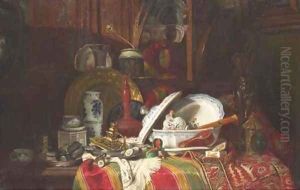Antoine-Guillaume Trinquier Paintings
Antoine-Guillaume Trinquier was a French artist born in 1756, who lived during a very turbulent period in French history that included the latter part of the reign of Louis XVI, the French Revolution, and the rise of Napoleon Bonaparte. Trinquier was primarily known as a painter, although not much is widely known or recorded about his personal life or professional training. What is clear, however, is that he worked during a time of great social and political upheaval, which would have influenced the art world and the themes prevalent in artistic works of the time.
Trinquier's career unfolded in a period when neoclassicism was the dominant art movement in France. This movement was characterized by a fascination with the art and culture of ancient Greece and Rome, and it emphasized qualities such as simplicity, clarity, and strong geometric lines. It was also a response to the preceding rococo style, which was seen as overly decorative and frivolous. Neoclassicism, with its emphasis on virtue and civic duty, found particular resonance during the French Revolution, when themes of liberty, democracy, and republicanism were in vogue.
Little specific information is available about Trinquier's own body of work, but it is likely that he produced paintings that in some way reflected the neoclassical style and the ideological shifts of his era. The lack of detailed records may be due in part to the chaos of the Revolution, which disrupted the lives and careers of many artists of the time. Furthermore, the art market and patronage system were undergoing significant changes, with the decline of aristocratic commissions and the rise of more public and governmental sponsorship.
Trinquier's death in 1799 came at the end of a decade of great instability in France. The Revolution had led to the Reign of Terror, during which many artists and intellectuals were viewed with suspicion and faced persecution. By the time of Trinquier's death, Napoleon Bonaparte had risen to power, and the Consulate period was beginning, which would lead to a new phase in French art. Unfortunately, due to the scarcity of information, Trinquier's contributions to the art world and how he navigated this complex period remain relatively obscure. His legacy, like that of many artists of the era, is a small piece in the broader mosaic of French art history, reflecting the challenges and transformations of his time.
